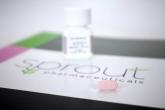News

FDA approves flibanserin for low female sexual desire
The Food and Drug Administration has approved flibanserin as the first drug treatment for acquired, generalized hypoactive sexual desire disorder...

EXPERT ANALYSIS FROM THE NAMS 2015 ANNUAL MEETING
LAS VEGAS – Female desire and sexual function involve a complicated and interconnected cascade of hormones and neurotransmitters, each providing a potential target for modulation in cases of low desire or sexual dysfunction.
There are some pharmacologic options available now and more drugs in the pipeline, Dr. Roya Rezaee said at the NAMS 2015 annual meeting.
Dr. Rezaee, codirector of the Program for Sexual Health and Vulvovaginal Disorders at University Hospitals Case Medical Center, Cleveland, explained how each treatment acts in the chemical cascade of desire and sexual response.* Though much remains unknown, researchers have identified neurochemical pathways of desire and arousal that act on the brain stem, the hypothalamus, and the amygdala.
Among the neurotransmitters and neurohormones thought to promote female sexual function, dopamine and melanocortin are associated with attention and desire, while norepinephrine and oxytocin are more directly related to arousal. Estrogen and testosterone function as excitatory neurohormones. Serotonin, because it is associated with satiety, may be inhibitory, as are prolactin and the endogenous opioids and endocannabinoids.
In the peripheral tissues, the presence of sex hormones maintains general genital function. For example, estradiol not only promotes vaginal lubrication, but also helps maintain adequate blood flow to the vagina and clitoris. Exogenous testosterone can directly influence the amount of unbound estrogen as well as testosterone, said Dr. Rezaee. Higher testosterone levels downregulate sex hormone–binding globulin, increasing circulating levels of free estrogen and testosterone.
“For women, low testosterone does not always correlate with low desire, but testosterone administration has been shown to be efficacious for low desire,” Dr. Rezaee said. “People are still writing prescriptions for testosterone off label, because a lot of us believe in the data,” she said, adding that a 2009 Cochrane review showed a good safety profile for testosterone.
Targeting dopaminergic pathways to increase desire, an extended-release daily oral combination of trazodone and bupropion, to be marketed as Lorexys, is about to begin phase III clinical trials. Bupropion, a norepinephrine and dopamine reuptake inhibitor, has been known to have prosexual side effects, Dr. Rezaee said. Both ingredients in Lorexys are currently approved as antidepressants.
Increasing available norepinephrine may help with focus and attention, and increase subjective sexual excitement. However, the ADHD and antidepressant medications that increase norepinephrine carry significant side effects and should not be what physicians use to help their patients with low desire, Dr. Rezaee said.
“Serotonin may have a role in low desire by acting as a sexual satiety signal, and SSRIs are serotonergic agents that inhibit desire, arousal, and orgasm in the brain and in the tissue,” she said.
However, there are seven known families of serotonin receptors, and selective modulation specifically of the 5-hydroxytryptamine receptor 1A and 5-HT2A receptors may have prosexual effects. The newly approved medication flibanserin (Addyi) is a selective agonist for 5-HT1A and an antagonist for 5-HT2A receptors. Flibanserin is also thought to produce upregulation in dopamine and norepinephrine in the prefrontal cortex, combating the satiety signals from serotonin and leading to increased desire.
Other medications that are 5-HT1A agonists with potential prosexual effects include buspirone (Buspar) and trazodone (Desyrel, Oleptro).
Blockade of phosphodiesterase type 5 (PDE5) permits relaxation of smooth muscles in arterial walls and increases blood flow to erectile tissues. PDE5 inhibitors such as sildenafil (Viagra) may be of benefit to some women as well, said Dr. Rezaee, though they do not address low desire.
“Newer data support the use of PDE5 inhibitors with women who suffer from SSRI-induced orgasmic complaints of increased latency or decreased intensity, or anorgasmia,” she said. A dose of 25-50 mg of sildenafil 1 hour before sexual activity may help these patients, she advised.
Phase II trials have been completed for two other combination drugs to treat female sexual problems. Lybrido is a combination of testosterone and sildenafil, while Lybridos combines testosterone with buspirone. Both products are oral tablets, taken on demand.
Bremelanotide is a first-in-class drug in development as a melanocortin agonist. This drug, meant to be used on demand to activate an endogenous pathway that increases attention and desire, is in phase III clinical trials.
Dr. Rezaee reported having no relevant financial disclosures.
koakes@frontlinemedcom.com
On Twitter @karioakes
*Correction, 10/20/2015: An earlier version of this story misstated Dr. Rezaee's title.

The Food and Drug Administration has approved flibanserin as the first drug treatment for acquired, generalized hypoactive sexual desire disorder...
